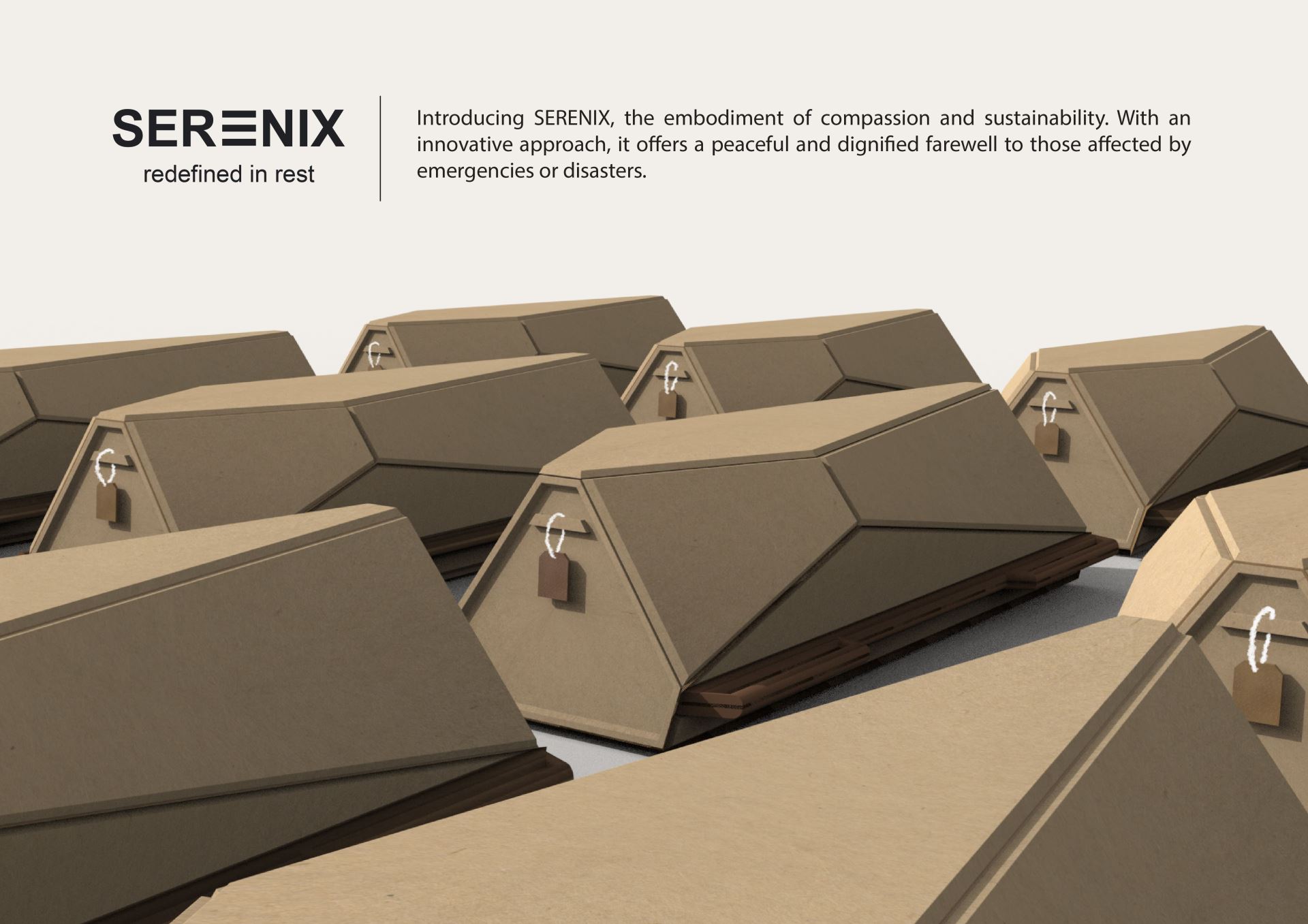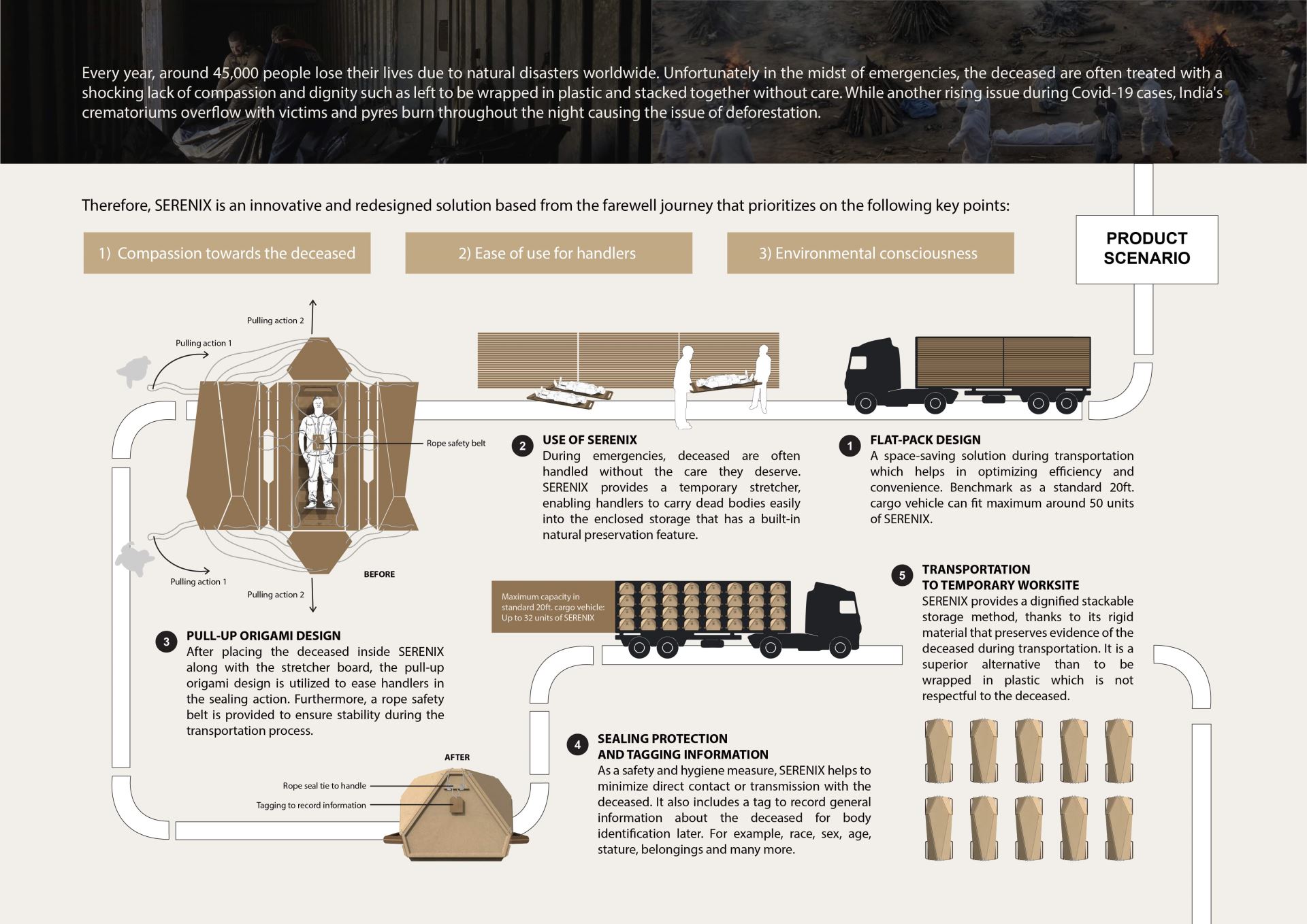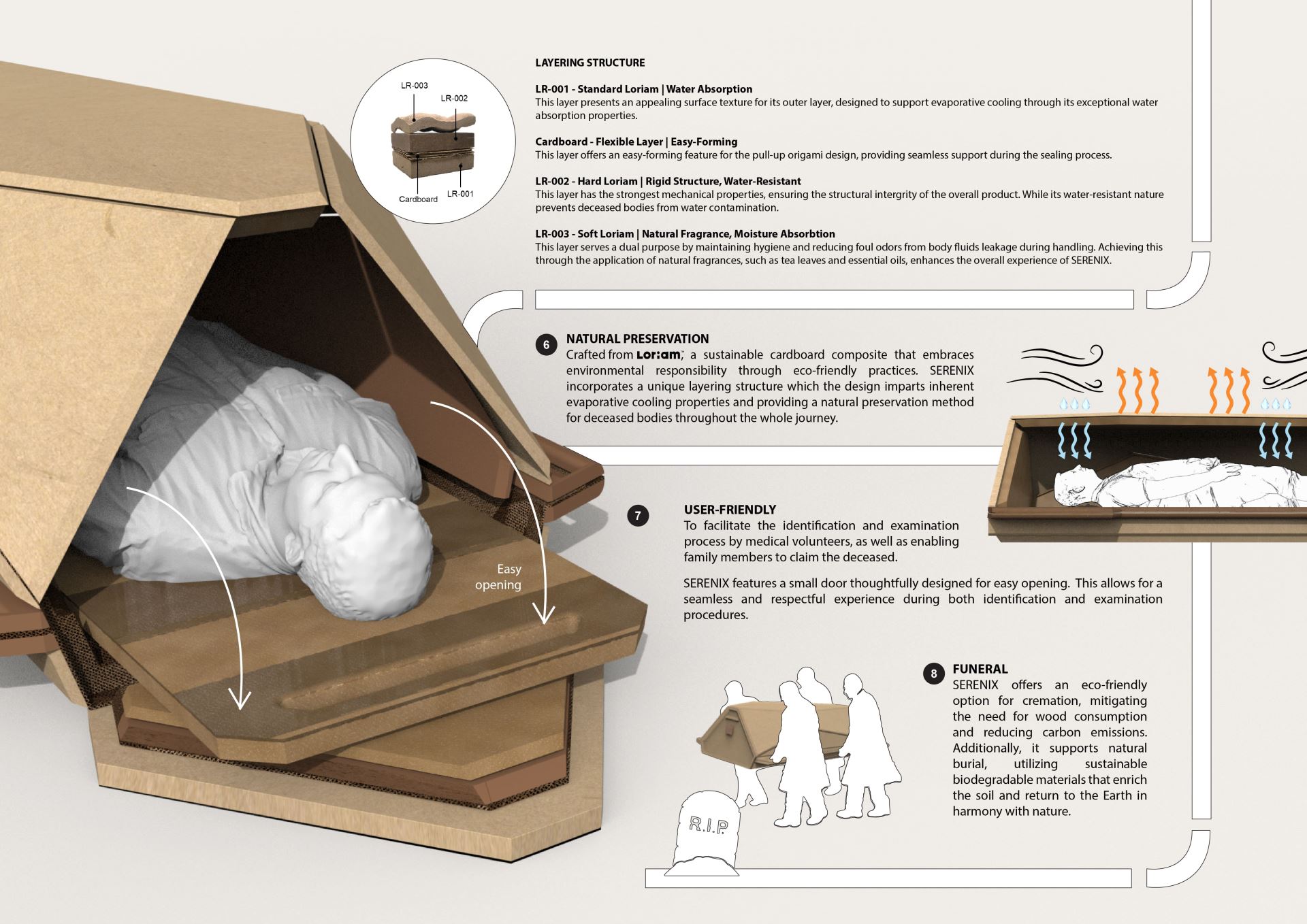


【獎項 Prizes】銀獎 Silver Award
【國家或地區 Country / Region】 馬來西亞 Malaysia
【設計團隊 Group / 設計師 Designer】 马惠梅 Bennie Beh Hue May, 卢欣阳 Loo Xin Yang, 張志健 Chong Chee Kin
【作品介紹 Description】
ERENIX: 憐憫、可持續性和尊嚴的化身 SERENIX ,安息的重新詮釋。
在這個世界上,緊急情況和自然災害時常不期而至,總是伴隨著破壞和人類痛苦。
在這些困難時刻,不僅是活著的人的生存是首要關注,尊重和尊嚴也變得至關重要,特別是對待逝者。
SERENIX是一個革命性的解決方案,它基於Loriam材料,這是一種可持續的紙板複合材料,為處理緊急情況中的逝者提供了一個具有再生設計概念的平臺。
SERENIX的特點:
平板設計
拉起摺疊設計
密封保護和標記信息
運輸到臨時工地
自然保存
用戶友好
喪禮選擇
SERENIX旨在解決處理逝者時缺乏憐憫和尊嚴的問題,尤其是在緊急情況和自然災害發生時,逝者通常遭受到缺乏尊重的待遇,有時甚至被包裹在塑料中或被忽視。這不僅對逝者不尊重,還對環境產生了負面影響,例如使用不可持續的材料和導致森林砍伐等問題。
此外,像COVID-19這樣的危機時刻,一些地區的火葬場被不斷使用,導致大量的焚燒和森林砍伐等問題。
SERENIX旨在提供一個解決方案,不僅應對處理逝者的實際挑戰,而且以憐憫和可持續性為考慮,同時兼顧了生存者和逝者的幸福,並考慮了對環境的長期影響。
SERENIX - A Regenerative Approach to Compassion, Sustainability, and Dignity
Introduction
In a world that often finds itself grappling with the unforgiving forces of nature, emergencies and natural disasters can strike with little warning, leaving in their wake a trail of devastation and human suffering. In these trying times, not only is the survival of the living a paramount concern, but the dignity and respect afforded to the departed also become a significant challenge. The concept of regenerative design, with its focus on creating systems that restore and renew, takes center stage in the innovative solution known as SERENIX. This article explores SERENIX as a regenerative approach to compassion, sustainability, and dignity in handling the deceased during emergencies.
Problem Statement
The problem statement that SERENIX aims to address is the lack of compassion and dignity in handling deceased individuals during emergencies and natural disasters. When such events occur, there is often a shocking lack of respect for the deceased, who are sometimes left wrapped in plastic or stacked together without care. This not only disrespects the departed but also has negative environmental consequences, such as the use of non-sustainable materials and deforestation.
Additionally, during crises like the COVID-19 pandemic, crematoriums in some regions have been overwhelmed, leading to issues like deforestation due to excessive pyre burning. SERENIX seeks to provide a solution that not only addresses the practical challenges of handling the deceased during emergencies but also does so with compassion and sustainability in mind.
The problem statement, therefore, encompasses both the need for a more dignified and compassionate approach to handling the deceased during emergencies and disasters and the need to do so in an environmentally responsible manner. SERENIX aims to provide a comprehensive solution that takes into account the well-being of both the living and the departed, while also considering the long-term impact on the environment.
The Roots of Regenerative Design
Regenerative design, a modern concept, draws inspiration from older practices like Indigenous land management. It gained prominence in the 1970s and 1980s through theorists like John T. Lyle and Bill McDonough, who advocated for systems that actively regenerate natural resources and ecosystems, beyond sustainability. It's closely related to sustainability, permaculture, and the circular economy, emphasizing responsible resource use and environmental stewardship.
SERENIX's Contribution to Regenerative Design
Whole Systems Thinking: Regenerative design involves understanding the interconnectedness of all system components. SERENIX's holistic approach, addressing not only environmental aspects but emotional and social dimensions, exemplifies this principle.
Net-Positive Impact: Regenerative design aims to benefit the environment and communities. SERENIX does so by handling the deceased with compassion and dignity, using materials that minimize environmental impact and promote recycling.
Closed-Loop Systems: SERENIX reduces waste through sustainable materials and eco-friendly practices in handling the deceased, aligning with regenerative design principles.
Social Equity: SERENIX promotes social equity by providing a dignified and compassionate solution designed to be user-friendly for both handlers and family members.
Co-creation with Nature: While not directly interacting with natural ecosystems, SERENIX's choice of sustainable materials and natural preservation features respects the natural world by minimizing harmful impacts and promoting eco-friendly practices.
SERENIX in Detail
SERENIX, the embodiment of compassion and sustainability, is a groundbreaking solution designed to offer a dignified farewell to those affected by emergencies or natural disasters. At its core is the innovative use of Loriam, a sustainable cardboard composite, which sets the stage for its regenerative design.
Loriam: The Sustainable Heart of SERENIX
Loriam, one of the primary components of SERENIX, is a material that stands as a testament to the principles of regenerative design. Developed by LESTARIAL, Loriam transforms recycled cardboard into a versatile and eco-friendly material. What makes Loriam unique is its ability to eliminate the need for harmful chemicals, ensuring 100% recyclability and enhancing its durability. The production process of Loriam is straightforward, reducing water and energy use, and it can find applications in various domains, aligning with the regenerative concept of creating systems that restore and renew. This sustainable material becomes the building block for SERENIX's design, incorporating its regenerative properties into the product.
The Components and Features of SERENIX SERENIX
encompasses various features that uphold the principles of regenerative design:
1. Flat-Pack Design The flat-pack design optimizes transportation efficiency, reducing the carbon footprint associated with moving such critical equipment during emergencies. This design also aligns with the principle of closed-loop systems by promoting reuse and minimizing waste.
2. Use of SERENIX In the midst of emergencies, the deceased are often handled without the care they deserve. SERENIX provides a temporary stretcher, enabling handlers to carry dead bodies easily into the enclosed storage that has a built-in natural preservation feature. This respects the dignity of the deceased and eliminates the need for more energy-intensive preservation methods.
3. Pull-Up Origami Design The pull-up origami design, used to seal SERENIX after placing the deceased inside, is an example of user-friendly and efficient design. It simplifies the process for handlers and reinforces the principle of whole systems thinking by considering the ease of use for the individuals involved in the process.
4. Sealing Protection and Tagging Information SERENIX includes a tag to record general information about the deceased, which not only assists in body identification but also reinforces the principle of social equity by providing important data for families seeking closure.
5. Transportation to Temporary Worksite SERENIX's stackable storage method, made possible by its durable Loriam material, aligns with the regenerative principle of closed-loop systems. This contrasts with the common practice of wrapping bodies in plastic, which is not respectful to the deceased and has a more significant environmental impact.
6. Natural Preservation Crafted from Loriam, SERENIX's inherent evaporative cooling properties provide a natural preservation method for deceased bodies throughout the whole journey. This element not only emphasizes sustainable materials but also reflects the regenerative approach of reducing the use of energy-intensive preservation techniques.
7. User-Friendly To facilitate the identification and examination process by medical volunteers and family members, SERENIX features a small door thoughtfully designed for easy opening. This aligns with the principle of social equity, ensuring that the product is accessible and respectful to all members of the community.
8. Funeral Options SERENIX offers eco-friendly options for cremation and natural burial, reducing the need for wood consumption and carbon emissions. These options align with the regenerative principles of closed-loop systems and net-positive impact by actively benefiting the environment.
Conclusion
SERENIX, a model of compassion and sustainability, showcases an innovative design rooted in regenerative principles like whole systems thinking and net-positive impact. It sets a significant standard in dignified deceased handling during emergencies. Additionally, its use of the sustainable material Loriam exemplifies regenerative design, demonstrating how compassionate solutions can also aid in environmental and societal restoration, bridging the well-being of the living and the departed in an era where both matters.



